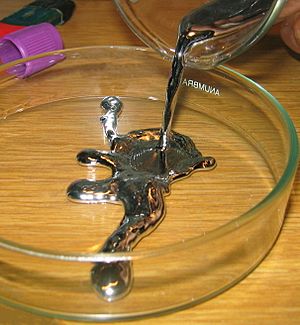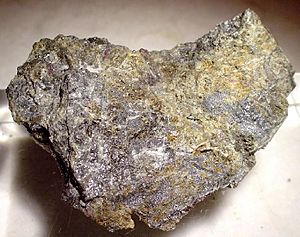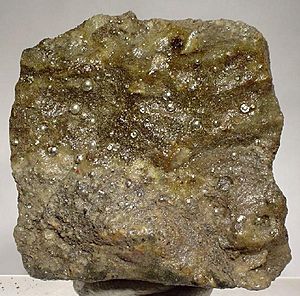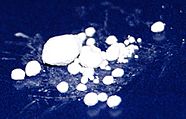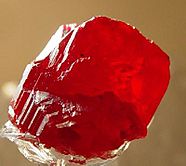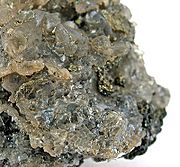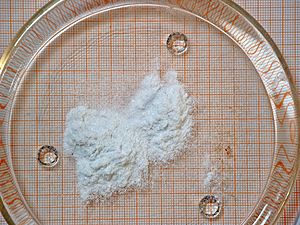Mercury (element) facts for kids
Mercury is a special chemical element that you might also know as quicksilver. Its symbol on the periodic table is Hg, and its atomic number is 80. This means each atom of mercury has 80 protons.
The symbol Hg comes from its old Latin and Greek name, hydrargyrum. This name means "watery silver" because mercury looks like liquid silver.
Contents
What is Mercury?

Mercury is a shiny, silvery-white metal. It's unique because it's the only metal that is a liquid at normal room temperature! Only one other element, Bromine, is also a liquid at room temperature.
Mercury is very heavy. If you put a piece of iron in mercury, the iron would float! It's not very good at letting heat pass through it, but it's pretty good at letting electricity pass.
How does Mercury react with other things?
Mercury doesn't easily react with air or water. It won't rust like iron unless there's a gas called hydrogen sulfide around. If you heat mercury in the air, it can turn into a red powder called mercury(II) oxide.
Mercury can mix with most other metals to form something called an "amalgam". It's like a special alloy. For example, it can mix with gold and silver. But it doesn't mix with iron, which is why people used to ship mercury in iron containers.
It's very dangerous to put mercury near aluminium. Mercury can slowly eat away at aluminium, even though aluminium usually has a protective layer. This process can keep going until a lot of the aluminium is gone.
Where does Mercury come from?
Mercury is a rare metal, about as common as silver. But it's not as expensive as silver because it's easier to get out of the ground.
You can sometimes find mercury as a liquid metal in nature, but this is rare. Most often, it's found in a red mineral called cinnabar. Cinnabar is a compound of mercury and sulfur. The biggest places where cinnabar is found are now in China.
How do we get Mercury?
Today, China and Kyrgyzstan are the main countries that produce mercury. To get mercury, they heat cinnabar in a special oven. This process turns the sulfur part into a gas, leaving the pure liquid mercury behind.
Mercury in History
No one knows who first discovered mercury because people have known about it for thousands of years! It was found in ancient Egyptian tombs from around 2000 BC.
Ancient people in China and Tibet believed that mercury could help them live longer and be healthier. There's a famous story about a Chinese emperor, Qin Shi Huang, who wanted to live forever. He drank a mix of mercury and powdered jade, hoping it would make him immortal. Instead, it made him very sick and led to his death.
The ancient Greeks used mercury in skin treatments. The Egyptians and Romans even used it in cosmetics. Sometimes, these cosmetics caused skin problems and made faces look worse!
What are Mercury Compounds?
Mercury can combine with other elements to form many different chemical compounds. These compounds can be in two main forms: mercury(I) compounds and mercury(II) compounds.
All mercury compounds are poisonous. The ones that dissolve in water are usually more dangerous than those that don't.
Mercury(I) Compounds
These are also called mercurous compounds. Most of them don't dissolve well in water, which makes them a bit less toxic than mercury(II) compounds. They are usually colorless or yellow.
- Mercury(I) chloride (also known as calomel) is a common example.
Mercury(II) Compounds
These are also called mercuric compounds. Many of them dissolve in water, making them very poisonous. They can be colorless, red, or orange.
- Mercury(II) oxide and mercury(II) chloride are common examples you might find in a science lab.
- Cinnabar is a mercury(II) sulfide mineral, which is red.
Organic Mercury Compounds
These are special compounds where mercury is connected to a carbon-based molecule. They are even more toxic than other mercury compounds because our bodies can absorb them very easily.
- Dimethylmercury is an example of an extremely toxic liquid organic mercury compound.
How is Mercury Used?
In the past, mercury had many uses, but because of its toxicity, many of these uses have stopped.
Medical Uses of Mercury (Past and Present)
- Dental Fillings: For a long time, mercury was used in dental fillings, mixed with other metals. Safer materials are now used instead.
- Medicines: Mercury compounds were once used in many medicines.
- Mercury(I) chloride (calomel) was used as a laxative and skin disinfectant.
- Mercury(II) chloride was used to treat some diseases, but it was very toxic, and its side effects were often confused with the diseases themselves.
- In the 1800s, a medicine called "blue mass" (which had mercury as a main ingredient) was given for many different problems, from constipation to toothaches.
- In the early 1900s, mercury was even given to children as a laxative and to treat worms.
- Vaccine Preservative: Since the 1930s, some vaccines have contained a mercury-based preservative called thiomersal. While some people worried it might cause autism, scientific studies have shown no link. Because of these concerns, thiomersal has been removed from most childhood vaccines in the U.S.
- Traditional Medicine: Cinnabar is still used in some traditional Chinese, Tibetan, and Ayurvedic medicines. However, some countries now ban mercury in drugs, so safer alternatives are being found.
- Medical Devices:
- Thermometers and blood pressure devices (like sphygmomanometers) used to contain mercury. Now, their use is declining and banned in many places due to safety concerns.
Other Uses of Mercury
- Cosmetics: Thiomersal is still used in some eye makeup, like mascara.
- Mining: Mercury was used to help extract gold and silver from their ores.
- Lamps: It's used in mercury-vapor lamps and fluorescent lamps, which produce light when electricity passes through mercury vapor.
- Measuring Devices: Besides thermometers, it was used in barometers (to measure air pressure) and manometers (to measure gas pressure).
- Electrical Switches: Some electrical switches use mercury to turn on or off when tilted.
The use of mercury around the world has greatly decreased since 1980 because of its dangers.
Why is Mercury Dangerous?
Mercury is very poisonous. Even breathing in its fumes can be harmful. The most dangerous forms are organic mercury compounds, which can be absorbed easily into the body, often through food. Inorganic mercury compounds, like those found in dust, are also very toxic if eaten or breathed in. Mercury can cause both short-term (acute) and long-term (chronic) poisoning.
In 1810, over 200 people died on a ship called Triumph because a barrel of mercury leaked.
Because mercury is so poisonous, it must be handled with extreme care. If mercury spills, there are special ways to clean it up. Small drops should be pushed together into a larger drop, then carefully scooped into a bag. You should never use a vacuum cleaner or a broom because they can spread the mercury even more. After cleaning, powders like sulfur or zinc can be sprinkled to help clean up any remaining tiny bits. Clothing that has touched mercury is very hard to clean and should usually be thrown away.
Images for kids
-
A pound coin (density ~7.6 g/cm3) floats on mercury due to the combination of the buoyant force and surface tension.
-
The bulb of a mercury-in-glass thermometer.
-
The deep violet glow of a mercury vapor discharge in a germicidal lamp, whose spectrum is rich in invisible ultraviolet radiation.
See also
 In Spanish: Mercurio (elemento) para niños
In Spanish: Mercurio (elemento) para niños
| Periodic table | |||||||||||||||||||||||||||||||||||||||||
|---|---|---|---|---|---|---|---|---|---|---|---|---|---|---|---|---|---|---|---|---|---|---|---|---|---|---|---|---|---|---|---|---|---|---|---|---|---|---|---|---|---|
| H | He | ||||||||||||||||||||||||||||||||||||||||
| Li | Be | B | C | N | O | F | Ne | ||||||||||||||||||||||||||||||||||
| Na | Mg | Al | Si | P | S | Cl | Ar | ||||||||||||||||||||||||||||||||||
| K | Ca | Sc | Ti | V | Cr | Mn | Fe | Co | Ni | Cu | Zn | Ga | Ge | As | Se | Br | Kr | ||||||||||||||||||||||||
| Rb | Sr | Y | Zr | Nb | Mo | Tc | Ru | Rh | Pd | Ag | Cd | In | Sn | Sb | Te | I | Xe | ||||||||||||||||||||||||
| Cs | Ba | La | Ce | Pr | Nd | Pm | Sm | Eu | Gd | Tb | Dy | Ho | Er | Tm | Yb | Lu | Hf | Ta | W | Re | Os | Ir | Pt | Au | Hg | Tl | Pb | Bi | Po | At | Rn | ||||||||||
| Fr | Ra | Ac | Th | Pa | U | Np | Pu | Am | Cm | Bk | Cf | Es | Fm | Md | No | Lr | Rf | Db | Sg | Bh | Hs | Mt | Ds | Rg | Cn | Uut | Fl | Uup | Lv | Uus | Uuo | ||||||||||
|
|||||||||||||||||||||||||||||||||||||||||


